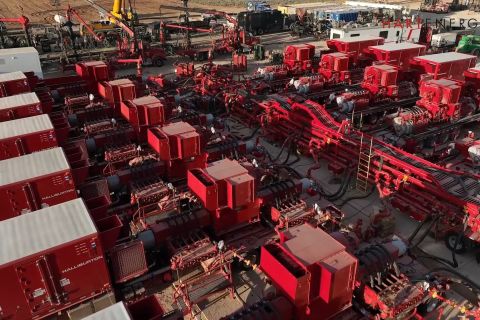John Kemp, Reuters
U.S. natural gas prices have surged to the highest level for more than 18 months as stocks continue to build more slowly than normal despite the warm weather.
The price for gas delivered to Henry Hub in March 2017 has risen by 11% since the end of September and is up by almost 44% since hitting a low back in February.
The structure of futures prices has also shifted from a big contango to a small backwardation, with near-term contracts rising much further than prices for deferred deliveries.
Futures markets are sending an urgent signal to gas producers about the need for more drilling and to electric utilities to run gas-fired plants for fewer hours this winter to conserve stocks.
Gas stocks typically rise between April and October and then draw down between November and March. But stocks have increased much more slowly than usual this year.
Stocks have risen by less than the five-year average every week since the start of May, a total of 23 consecutive weeks, according to data from the U.S. Energy Information Administration.
The result is that the gas market has swung from a huge surplus at the end of the first quarter close to balance by the end of the third quarter and is on track for a deficit in 2017.
Stocks were 1,014 billion cubic feet (Bcf) above prior-year levels in late March but by the end of the first week in October the surplus had shrunk to just 28 Bcf.
Market Rebalanced
Gas production has been falling since April as low prices forced many gas companies to scale back drilling programs.
The number of rigs targeting gas-rich formations fell to a low of just 81 in early August, down from 213 a year earlier, according to Baker Hughes.
At the same time, gas exports have risen to record levels this year both by pipeline and through newly built liquefied natural gas terminals.
And domestic consumption has increased sharply as power producers have burned record quantities of cheap gas.
A big part of the reason for the power burn this summer was the run of hot weather which saw temperatures consistently above normal from the end of May boosting demand for air conditioning.
Power producers have also installed an increasingly large fleet of gas-fired plants and have run them for more hours this year to take advantage of cheap gas at the expense of coal.
Production down. Exports up. Consumption up. The net result is gas stocks have increased by less than in 2015 even allowing for demand driven by the unusually hot weather.
The market has continued to tighten, even as the summer cooling season ends and the winter heating season begins.
The run of warm weather continued through September and the first half of October sharply cutting heating demand for gas.
Heating demand, as measured by population-weighted heating degree days, has been 46% lower than in 2015 and 63% below the long-term average.
The mild start to the heating season should have caused gas stocks to rise more than usual. But instead they have continued to build by less than normal.
In the first week in October, stocks rose by just 79 Bcf, compared with a five-year seasonal average of 92 Bcf. Stocks are rising by much less than in 2015 even adjusting for the weather.
Deficit Ahead
The continued tightening of the supply-demand balance despite a mild start to the heating season has sparked concerns about a potential deficit in 2017 unless production increases and consumption growth slows.
Futures prices for all maturities have risen sharply but the rally has been especially sharp for contracts expiring in the remainder of 2016 and the first half of 2017.
The market will rebalance again through a combination of more drilling, lower exports and reduced power burn from combined-cycle gas turbines (CCGTs).
In practice, the biggest short-term shift is likely to come through a moderation in exports and a reduction in the number of hours that CCGTs operate during the winter and in summer 2017.
CCGT utilization rates have been trending upward and reached record levels during the first half of 2016 as power producers took advantage of cheap gas and reduced their use of coal-fired power stations.
Higher gas prices should reduce the number of hours that CCGTs generate during the winter months conserving gas.
But because much of the gas is contracted months in advance and only a relatively small proportion is bought on the spot market, fairly large price increases are needed to curb consumption.
Still, with gas prices up by more than $1 per million British thermal units since February, there should be a reduction in generating hours by CCGTs this winter and a comparable increase in generating hours at coal-fired units.
Hedge funds and other money managers finally began to take notice of the gas market tightening in mid-August.
Hedge funds' net long position in the two major natural gas futures and options contracts surged from a low of 622 Bcf on Aug. 16 to 2,565 Bcf on Sept. 27.
Profit-taking reduced the net long position slightly to 2,364 Bcf during the first week of October but there were still enough short positions in the market to add fuel to the subsequent rally.
The physical market is genuinely tightening but with prices having risen nearly 50% in less than 8 months and a large net long position already established the risks of a short-term price reversal have increased.
The biggest source of uncertainty is the weather. The current consensus forecast is for a winter colder than 2015-2016 but still warmer than average.
If the forecast proves accurate, the gas market should rebalance without too much difficulty. But a period of sustained cold would boost demand for heating and from CCGTs and could trigger a much bigger spike in prices.
Recommended Reading
Dragos: IP Theft, Targeted OT Attacks on the Rise
2024-02-20 - Dragos’ annual cybersecurity review reveals three new threat groups, and the company’s CEO urges focus on specific vulnerabilities.
Tech Trends: Autonomous Drone Aims to Disrupt Subsea Inspection
2024-01-30 - The partners in the project are working to usher in a new era of inspection efficiencies.
Exclusive: Halliburton’s Frac Automation Roadmap
2024-03-06 - In this Hart Energy Exclusive, Halliburton’s William Ruhle describes the challenges and future of automating frac jobs.
CERAWeek: Large Language Models Fuel Industry-wide Productivity
2024-03-21 - AI experts promote the generative advantage of using AI to handle busywork while people focus on innovations.
Tech Trends: Safety, Speed, Savings: Automation is Transforming Drilling
2024-03-26 - Drilling is getting smarter through automation, delivering efficiency, consistency and reliability.





